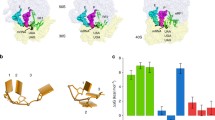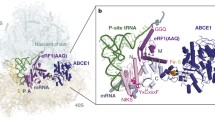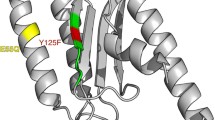Abstract
Peptide synthesis in eukaryotes terminates when eukaryotic release factor 1 (eRF1) binds to an mRNA stop codon and occupies the ribosomal A site. Domain 1 of the eRF1 protein has been implicated in stop codon recognition in a number of experimental studies. In order to further pinpoint the residues of this protein involved in stop codon recognition, we sequenced and compared eRF1 genes from a variety of ciliated protozoan species. We then performed a series of computational analyses to evaluate the conservation, accessibility, and structural environment of each amino acid located in domain 1. With this new dataset and methodology, we were able to identify eight specific amino acid sites important for stop codon recognition and also to propose a set of cooperative paired substitutions that may underlie stop codon reassignment. Our results are more consistent with current experimental data than previously described models.



Similar content being viewed by others
References
G Bertram HA Bell DW Ritchie G Fullerton I Stansfield (2000) ArticleTitleTerminating eukaryote translation: domain 1 of release factor eRF1 functions in stop codon recognition RNA 6 1236–1247 Occurrence Handle1:CAS:528:DC%2BD3cXms1Cis7c%3D Occurrence Handle10999601
L Chavatte L Frolova L Kisselev A Favre (2001) ArticleTitleThe polypeptide chain release factor eRF1 specifically contacts the s(4)UGA stop codon located in the A site of eukaryotic ribosomes Eur J Biochem 268 2896–2904 Occurrence Handle1:CAS:528:DC%2BD3MXktVSkt7k%3D Occurrence Handle11358506
L Chavatte A Seit-Nebi V Dubovaya A Favre (2002) ArticleTitleThe invariant uridine of stop codons contacts the conserved NIKSR loop of human eRF1 in the ribosome EMBO J 21 5302–5311 Occurrence Handle1:CAS:528:DC%2BD38Xns1Cms70%3D Occurrence Handle12356746
L Chavatte L Frolova P Laugaa L Kisselev A Favre (2003a) ArticleTitleStop codons and UGG promote efficient binding of the polypeptide release factor eRF1 to the ribosomal A site J Mol Biol 331 745–758 Occurrence Handle1:CAS:528:DC%2BD3sXlvFGgu7w%3D
L Chavatte S Kervestin A Favre O Jean-Jean (2003b) ArticleTitleStop codon selection in eukaryotic translation termination: comparison of the discriminating potential between human and ciliate eRF1s EMBO J 22 1644–1653 Occurrence Handle1:CAS:528:DC%2BD3sXisFeqsbg%3D
EA Curtis LF Landweber (1999) ArticleTitleEvolution of gene scrambling in ciliate micronuclear genes Ann NY Acad Sci 870 349–350 Occurrence Handle1:CAS:528:DyaK1MXkslGmsrk%3D Occurrence Handle10415495
LY Frolova RY Tsivkovskii GF Sivolobova NY Oparina OI Serpinsky VM Blinov SI Tatkov LL Kisselev (1999) ArticleTitleMutations in the highly conserved GGQ motif of class 1 polypeptide release factors abolish ability of human eRF1 to trigger peptidyl-tRNA hydrolysis RNA 5 1014–1020 Occurrence Handle1:CAS:528:DyaK1MXltFCmsrs%3D Occurrence Handle10445876
L Frolova A Seit-Nebi L Kisselev (2002) ArticleTitleHighly conserved NIKS tetrapeptide is functionally essential in eukaryotic translation termination factor eRF1 RNA 8 129–136 Occurrence Handle1:CAS:528:DC%2BD38Xis1WltL0%3D Occurrence Handle11911360
EA Hewitt KM Muller J Cannone DJ Hogan R Gutell DM Prescott (2003) ArticleTitlePhylogenetic relationships among 28 spirotrichous ciliates documented by rDNA Mol Phylogenet Evol 29 258–267 Occurrence Handle1:CAS:528:DC%2BD3sXnt1amtr8%3D Occurrence Handle13678681
Y Inagaki C Blouin WF Doolittle AJ Roger (2002) ArticleTitleConvergence and constraint in eukaryotic release factor 1 (eRF1) domain 1: the evolution of stop codon specificity Nucleic Acids Res 30 532–544 Occurrence Handle1:CAS:528:DC%2BD38XhtFCgt7k%3D Occurrence Handle11788716
K Ito K Ebihara M Uno Y Nakamura (1996) ArticleTitleConserved motifs in prokaryotic and eukaryotic polypeptide release factors: tRNA-protein mimicry hypothesis Proc Natl Acad Sci USA 93 5443–5448 Occurrence Handle1:CAS:528:DyaK28Xjt1Ojs7c%3D Occurrence Handle8643594
K Ito K Ebihara Y Nakamura (1998) ArticleTitleThe stretch of C-terminal acidic amino acids of translational release factor eRF1 is a primary binding site for eRF3 of fission yeast RNA 4 958–972 Occurrence Handle1:CAS:528:DyaK1cXltFykt78%3D Occurrence Handle9701287
K Ito M Uno Y Nakamura (2000) ArticleTitleA tripeptide ‘anticodon’ deciphers stop codons in messenger RNA Nature 403 680–684 Occurrence Handle1:CAS:528:DC%2BD3cXht1yjurs%3D Occurrence Handle10688208
K Ito L Frolova A Seit-Nebi A Karamyshev L Kisselev Y Nakamura (2002) ArticleTitleOmnipotent decoding potential resides in eukaryotic translation termination factor eRF1 of variant-code organisms and is modulated by the interactions of amino acid sequences within domain 1 Proc Natl Acad Sci USA 99 8494–8499 Occurrence Handle1:CAS:528:DC%2BD38XltF2iu7k%3D Occurrence Handle12084909
S Kervestin L Frolova L Kisselev O Jean-Jean (2001) ArticleTitleStop codon recognition in ciliates: Euplotes release factor does not respond to reassigned UGA codon EMBO Rep 2 680–684 Occurrence Handle1:CAS:528:DC%2BD3MXmt1Olsbs%3D Occurrence Handle11463747
RD Knight SJ Freeland LF Landweber (2001) ArticleTitleRewiring the keyboard: Evolvability of the genetic code Nat Rev Genet 2 49–58 Occurrence Handle1:CAS:528:DC%2BD3MXisVGjs7g%3D Occurrence Handle11253070
P Koehl M Delarue (1994) ArticleTitlePolar and nonpolar atomic environments in the protein core: implications for folding and binding Proteins 20 264–278 Occurrence Handle1:CAS:528:DyaK2MXisVGju7k%3D Occurrence Handle7892175
R Landgraf I Xenarios D Eisenberg (2001) ArticleTitleThree-dimensional cluster analysis identifies interfaces and functional residue clusters in proteins J Mol Biol 307 1487–1502 Occurrence Handle1:CAS:528:DC%2BD3MXisVKntrg%3D Occurrence Handle11292355
O Lichtarge HR Bourne FE Cohen (1996) ArticleTitleAn evolutionary trace method defines binding surfaces common to protein families J Mol Biol 257 342–358 Occurrence Handle1:CAS:528:DyaK28XhvVOqsLw%3D Occurrence Handle8609628
CA Lozupone RD Knight LF Landweber (2001) ArticleTitleThe molecular basis of nuclear genetic code change in ciliates Curr Biol 11 65–74 Occurrence Handle1:CAS:528:DC%2BD3MXhtVSgtbo%3D Occurrence Handle11231122
T Muramatsu K Heckmann C Kitanaka Y Kuchino (2001) ArticleTitleMolecular mechanism of stop codon recognition by eRF1: a wobble hypothesis for peptide anticodons FEBS Lett 488 105–109 Occurrence Handle1:CAS:528:DC%2BD3MXhsVSrs7k%3D Occurrence Handle11163755
Y Nakamura K Ito (1998) ArticleTitleHow protein reads the stop codon and terminates translation Genes Cells 3 265–278 Occurrence Handle1:CAS:528:DyaK1cXltFOqtbs%3D Occurrence Handle9685178
Y Nakamura K Ito M Ehrenberg (2000) ArticleTitleMimicry grasps reality in translation termination Cell 101 349–352 Occurrence Handle1:CAS:528:DC%2BD3cXjsFekurg%3D Occurrence Handle10830162
DM Prescott JD Prescott RM Prescott (2002) ArticleTitleCoding properties of macronuclear DNA molecules in Sterkiella nova (Oxytricha nova) Protist 153 71–77 Occurrence Handle1:CAS:528:DC%2BD38XktlSjs7k%3D Occurrence Handle12022278
A Seit-Nebi L Frolova L Kisselev (2002) ArticleTitleConversion of omnipotent translation termination factor eRF1 into ciliate-like UGA-only unipotent eRF1 EMBO Rep 3 881–886 Occurrence Handle1:CAS:528:DC%2BD38Xnt1GntLs%3D Occurrence Handle12189178
H Song P Mugnier AK Das HM Webb DR Evans MF Tuite BA Hemmings D Barford (2000) ArticleTitleThe crystal structure of human eukaryotic release factor eRF1—Mechanism of stop codon recognition and peptidyl-tRNA hydrolysis Cell 100 311–321 Occurrence Handle1:CAS:528:DC%2BD3cXhtFKjtLc%3D Occurrence Handle10676813
JD Thompson DG Higgins TJ Gibson (1994) ArticleTitleCLUSTAL W: improving the sensitivity of progressive multiple sequence alignment through sequence weighting, position-specific gap penalties and weight matrix choice Nucleic Acids Res 22 4673–4680 Occurrence Handle1:CAS:528:DyaK2MXitlSgu74%3D Occurrence Handle7984417
AH van Hoek TA van Alen VS Sprakel JH Hackstein GD Vogels (1998) ArticleTitleEvolution of anaerobic ciliates from the gastrointestinal tract: phylogenetic analysis of the ribosomal repeat from Nyctotherus ovalis and its relatives Mol Biol Evol 15 1195–1206 Occurrence Handle1:CAS:528:DyaK1cXls1KisL8%3D Occurrence Handle9729884
Acknowledgments
The authors would like to thank Drs. Wei-Jen Chang and Mona Singh for helpful discussions, Nicholas Stover for critical manuscript reading, and David Prescott, Johannes Hackstein, Mann-Kyoon Shin, and Wei-Jen Chang for gifts of cells or DNA. We thank two anonymous reviewers for their valuable suggestions. This work was supported by NIGMS Grant GM59708 and NSF Award 9875184 to L.F.L.
Author information
Authors and Affiliations
Corresponding author
Additional information
Han Liang, Jonathan Y. Wong,Contributed equally to this paper
ReviewingEditor: Dr. Niles Lehman
Rights and permissions
About this article
Cite this article
Liang, H., Wong, J.Y., Bao, Q. et al. Decoding the Decoding Region: Analysis of Eukaryotic Release Factor (eRF1) Stop Codon-Binding Residues. J Mol Evol 60, 337–344 (2005). https://doi.org/10.1007/s00239-004-0211-8
Received:
Accepted:
Issue Date:
DOI: https://doi.org/10.1007/s00239-004-0211-8




